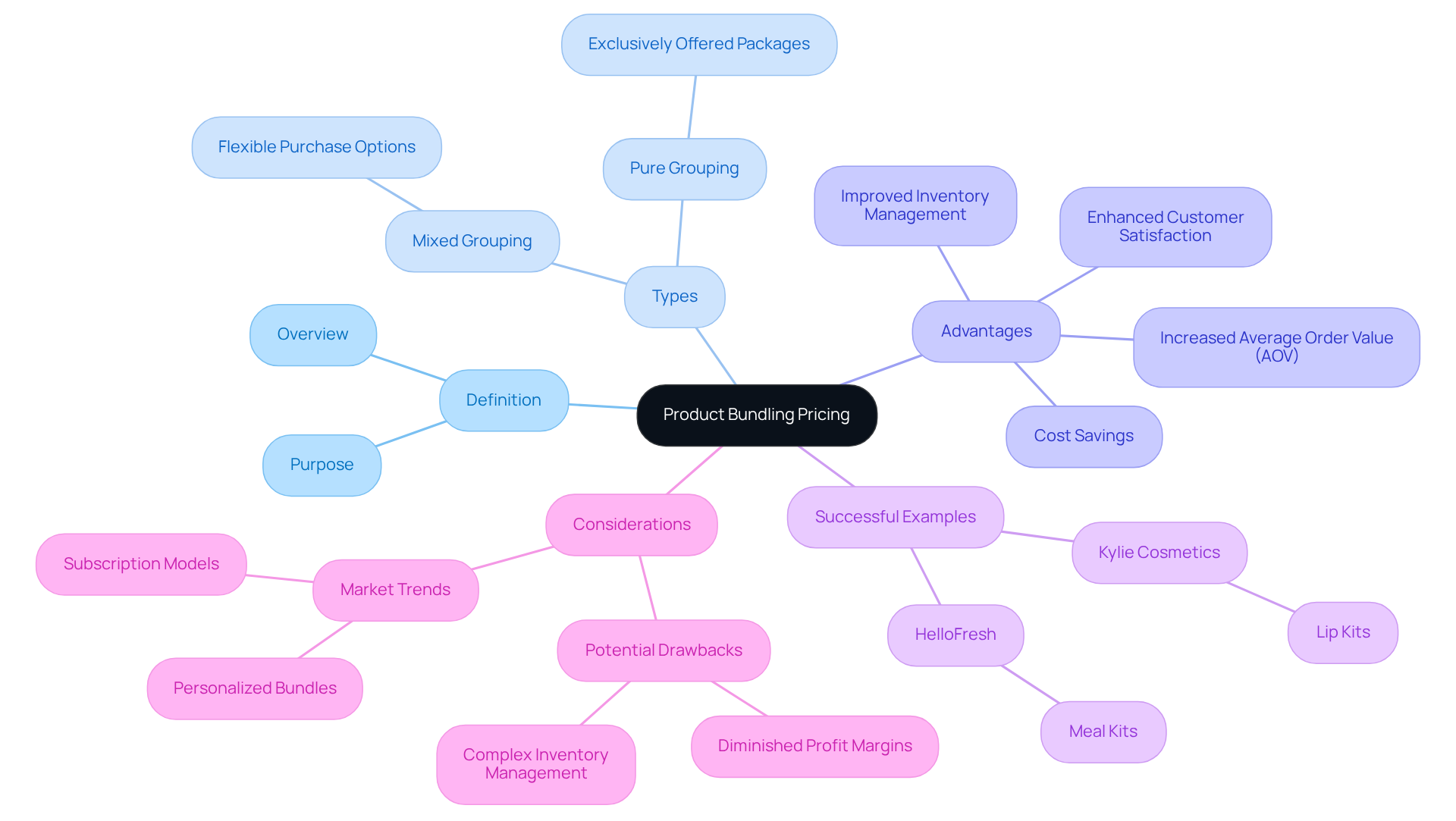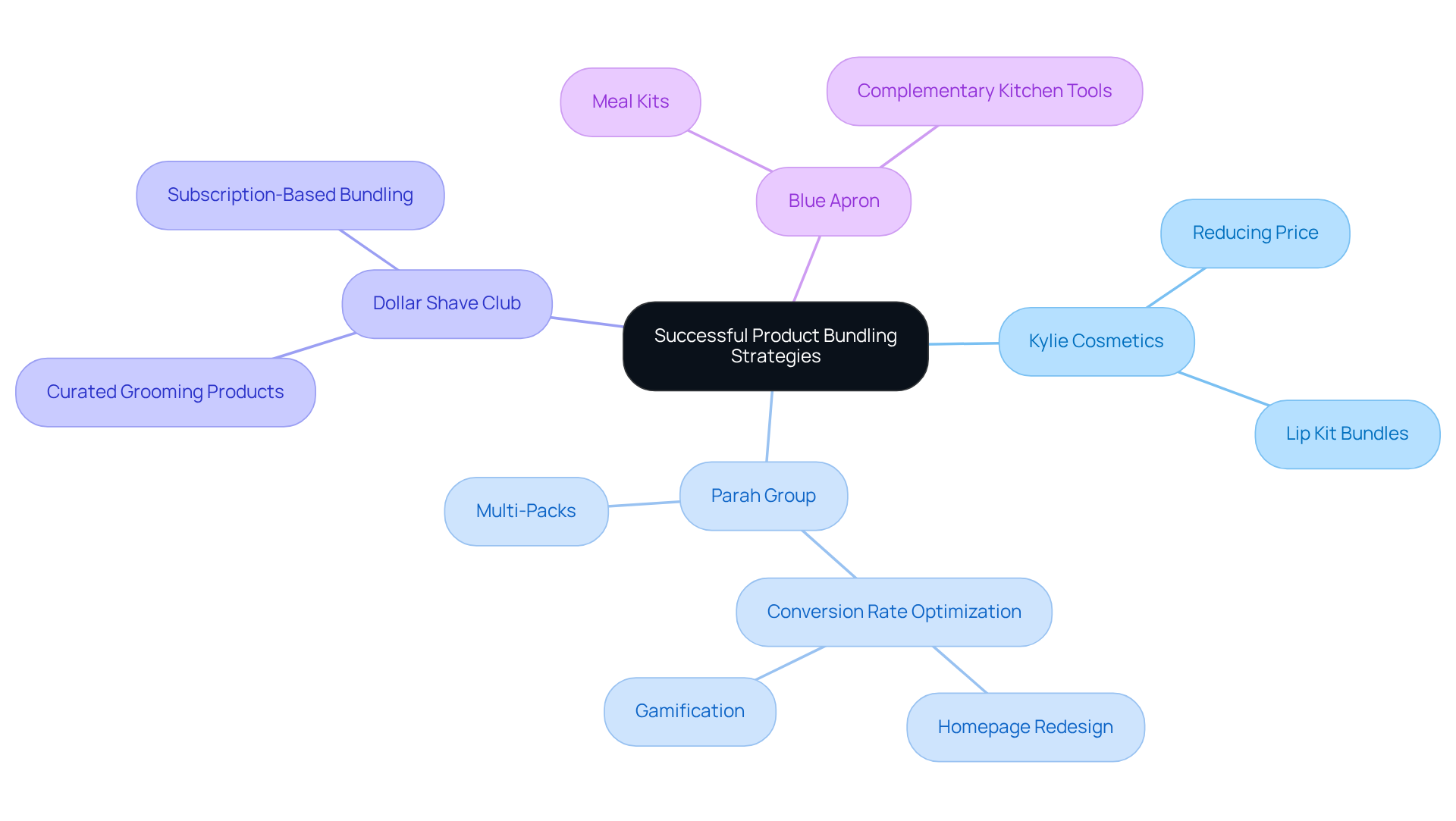
Overview
Product bundling pricing represents a strategic marketing approach that combines multiple products at a reduced price compared to individual purchases. This tactic proves especially advantageous for direct-to-consumer (DTC) brands. Notably, this strategy not only boosts average order value and mitigates cart abandonment but also elevates customer satisfaction and loyalty.
Successful case studies, such as Kylie Cosmetics and Grab Green, underscore the effectiveness of product bundling in driving sales and enhancing brand engagement. The evidence is clear: implementing this strategy can significantly transform a brand's market presence.
Introduction
The landscape of direct-to-consumer (DTC) marketing is rapidly evolving, compelling brands to seek innovative strategies to capture consumer attention and drive sales effectively. Among these strategies, product bundling pricing is gaining significant traction. This method not only enhances perceived value but also encourages customers to purchase more, thereby increasing overall sales volume.
As DTC brands navigate a competitive marketplace, a pivotal question emerges: how can effective bundling strategies transform customer engagement and boost profitability? This article delves into the intricacies of product bundling pricing, exploring its significance and benefits. Additionally, it will highlight successful tactics that can elevate DTC brands to new heights, providing actionable insights for marketers eager to leverage this powerful approach.
Define Product Bundling Pricing
What is product bundling pricing? It is a strategic marketing approach that involves offering multiple items together at a price lower than the total cost of acquiring each individually, which captures attention and drives consumer behavior. This method not only encourages clients to buy more products but also enhances the perceived value of the offer, illustrating what is product bundling pricing and making it increasingly attractive. Grouping can manifest in various forms, such as:
- Pure grouping, where items are exclusively offered as a package
- Mixed grouping, which allows buyers to purchase goods either separately or as part of a set
This strategy is particularly advantageous for direct-to-consumer (DTC) enterprises aiming to maximize average order values (AOV) and elevate client satisfaction.
In 2025, the anticipated impact of product grouping on consumer buying habits is expected to be significant, as buyers increasingly seek value-oriented deals. Successful e-commerce examples, such as Kylie Cosmetics' lip kits—contributing to a $600 million acquisition—and HelloFresh's meal kits, illustrate how effective packaging can enhance sales and foster brand loyalty. Marketing specialists assert that well-executed packages not only boost sales revenue but also improve client engagement by streamlining the purchasing process and reducing decision fatigue. For instance, a study by Vineet Kumar of Harvard Business School found that mixed grouping can substantially increase sales by offering customers the flexibility to buy items separately or as part of a discounted package.
However, it is crucial to consider potential drawbacks, such as the risk of diminished profit margins due to excessive discounts. By understanding what is product bundling pricing and implementing effective pricing strategies for packages, DTC companies can better navigate the competitive landscape and enhance their revenue potential.

Explain the Importance for DTC Brands
For DTC companies, product bundling pricing is essential for several persuasive reasons. Primarily, it can lead to a significant increase in average order value (AOV) by encouraging customers to purchase multiple items simultaneously, thereby boosting overall sales. For instance, a $15M revenue cleaning product brand, Grab Green, implemented bundles and multi-packs, resulting in an impressive 80% increase in AOV. Research indicates that package deals can elevate AOV by as much as 30%, making it a powerful strategy for enhancing profitability.
Moreover, combining products effectively reduces cart abandonment rates. Customers often perceive greater value in purchasing a bundle compared to individual items, which can motivate them to complete their transactions. This perception of value is crucial, especially considering that many consumers cite free delivery as a deciding factor in their online purchases. By strategically establishing minimum cart thresholds for free shipping, companies can further encourage shoppers to choose bundles. The case study of STRNG Seeds illustrates how introducing free gifts over a certain cart size significantly improved their AOVs and conversion rates.
In addition, product combination enables companies to manage inventory more effectively by pairing slower-moving items with top sellers. This approach not only helps clear out excess stock but also maintains a balanced inventory, addressing the estimated 20 to 30 percent of deadstock that many e-commerce sellers face.
Ultimately, bundling enhances client satisfaction by offering a convenient and customized shopping experience. By providing curated bundles that satisfy specific needs, companies cultivate loyalty and promote repeat purchases. This strategy highlights product bundling pricing by generating perceived value through careful combinations of offerings, ultimately resulting in a more engaged customer base. The proven results from Parah Group's case studies highlight the transformative impact of these strategies on DTC profitability.

Explore Strategies and Types of Product Bundling
DTC brands can leverage various strategies and types of bundling to understand what is product bundling pricing, thereby enhancing their offerings. Among the most effective are:
- Pure Bundling: In this approach, products are exclusively available as part of a bundle, fostering a sense of exclusivity among consumers.
- Mixed Bundling: This strategy allows products to be purchased either separately or as part of a bundle, thereby providing clients with flexibility in their purchasing decisions.
- Cross-Selling Bundles: By grouping complementary items together, brands can encourage buyers to purchase related goods, enhancing the overall value.
- Discount Bundles: Offering customers a discount on bundled purchases incentivizes larger transactions, driving sales and increasing customer satisfaction.
Additionally, brands can implement innovative strategies such as seasonal packaging, which aligns products with seasonal trends, or subscription packaging, allowing clients to receive regular shipments of curated items. Understanding what is product bundling pricing allows each of these strategies to be tailored to meet specific client needs and preferences, ultimately enriching the shopping experience and fostering brand loyalty.

Present Examples of Successful Product Bundling
Many DTC companies have successfully harnessed bundling strategies to amplify their sales and enhance client loyalty. For instance, Kylie Cosmetics offers bundles of lip kits featuring various shades at a reduced price, motivating buyers to explore a broader selection of offerings. This approach not only elevates the average order value (AOV) but also fosters customer loyalty, as individuals are more inclined to return for subsequent purchases. Industry insights reveal that merchandise bundling can contribute to 10-30% of eCommerce revenues, underscoring its effectiveness in driving sales growth.
Parah Group has adeptly executed similar strategies across different labels. A notable example is the $15M revenue cleaning brand, Grab Green, which faced challenges with low AOVs and high customer acquisition costs (CACs). By introducing bundles and multi-packs, they incentivized larger purchases, resulting in an impressive 80% increase in AOV. This case highlights how strategic grouping, bolstered by conversion rate optimization (CRO) methods such as homepage redesign and gamification, can significantly enhance profitability.
Dollar Shave Club exemplifies the success of subscription-based bundling, where individuals receive a curated selection of grooming products each month. This model not only guarantees steady revenue but also enhances client retention by offering convenience and value.
Similarly, Blue Apron combines meal kits with complementary kitchen tools, enriching the cooking experience for users. This strategy streamlines meal preparation and promotes repeat purchases, as buyers appreciate the added benefit of bundled items.
These examples demonstrate what is product bundling pricing, as it is supported by proven CRO strategies from Parah Group, which can lead to substantial sales growth, improved customer satisfaction, and stronger brand loyalty. This makes understanding what is product bundling pricing a vital strategy for DTC brands aiming to thrive in a competitive market.

Conclusion
Product bundling pricing emerges as a pivotal strategy for direct-to-consumer (DTC) brands, effectively combining multiple products into one attractive package at a reduced price. This approach not only enhances the perceived value for consumers but also encourages larger purchases, ultimately driving sales and fostering customer loyalty. By leveraging this pricing strategy, DTC companies can significantly increase their average order value while simultaneously enhancing the shopping experience.
Key insights reveal how product bundling can lead to substantial benefits for DTC brands. These include:
- Increased average order values
- Reduced cart abandonment rates
- Improved inventory management
Successful companies like Kylie Cosmetics and Grab Green illustrate the tangible results of implementing strategic bundling, showcasing its potential to elevate sales and customer satisfaction. Furthermore, the exploration of various bundling types, such as pure and mixed bundling, highlights the flexibility available to brands in crafting tailored offers that resonate with their target audience.
In a competitive market, the significance of product bundling pricing cannot be overstated. By embracing this strategy, DTC brands not only meet consumer demands for value-oriented deals but also create opportunities for deeper customer engagement and loyalty. As brands continue to innovate and refine their bundling strategies, the potential for increased profitability and market presence becomes all the more attainable. Embracing product bundling is not just a tactical move; it is a transformative approach that can redefine the customer experience and drive long-term success in the direct-to-consumer landscape.
Frequently Asked Questions
What is product bundling pricing?
Product bundling pricing is a strategic marketing approach that involves offering multiple items together at a price lower than the total cost of acquiring each individually. This method captures consumer attention, encourages clients to buy more products, and enhances the perceived value of the offer.
What are the different forms of product bundling?
The two main forms of product bundling are pure grouping, where items are exclusively offered as a package, and mixed grouping, which allows buyers to purchase goods either separately or as part of a set.
How does product bundling benefit direct-to-consumer (DTC) businesses?
Product bundling is particularly advantageous for DTC enterprises as it helps maximize average order values (AOV) and elevate client satisfaction.
What impact is product bundling expected to have on consumer buying habits in 2025?
In 2025, product bundling is expected to significantly impact consumer buying habits as buyers increasingly seek value-oriented deals.
Can you provide examples of successful product bundling in e-commerce?
Successful e-commerce examples include Kylie Cosmetics' lip kits, which contributed to a $600 million acquisition, and HelloFresh's meal kits, which illustrate how effective packaging can enhance sales and foster brand loyalty.
What benefits do marketing specialists associate with well-executed product bundles?
Marketing specialists assert that well-executed bundles boost sales revenue, improve client engagement, streamline the purchasing process, and reduce decision fatigue.
What does research say about mixed grouping in product bundling?
A study by Vineet Kumar of Harvard Business School found that mixed grouping can substantially increase sales by offering customers the flexibility to buy items separately or as part of a discounted package.
What are the potential drawbacks of product bundling pricing?
Potential drawbacks include the risk of diminished profit margins due to excessive discounts.
How can DTC companies effectively implement product bundling pricing strategies?
By understanding product bundling pricing and implementing effective pricing strategies for packages, DTC companies can better navigate the competitive landscape and enhance their revenue potential.
FAQs











